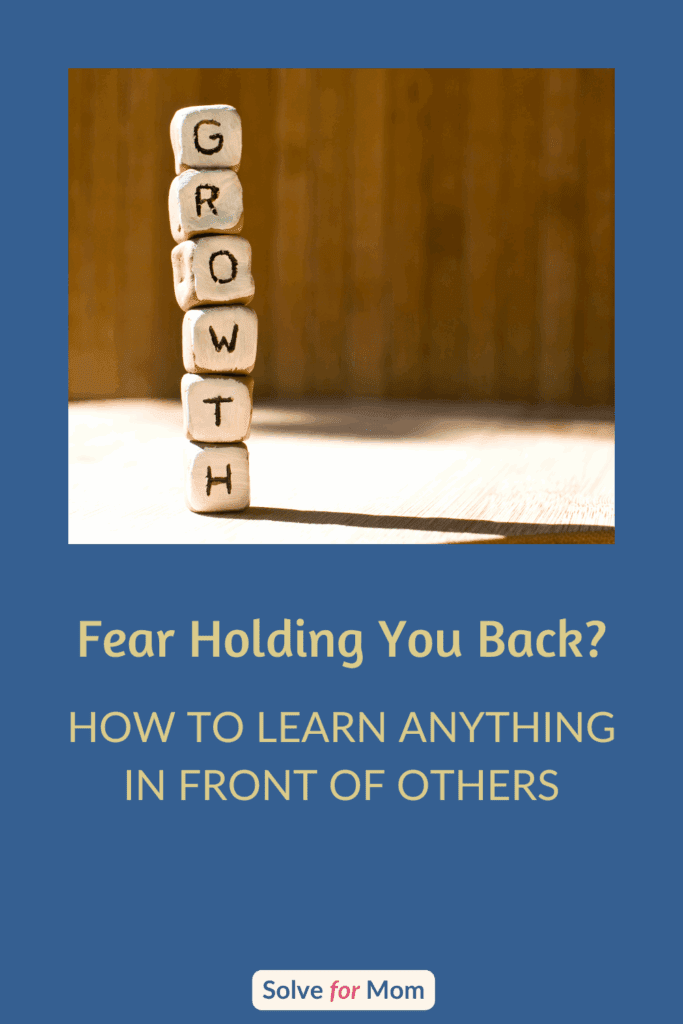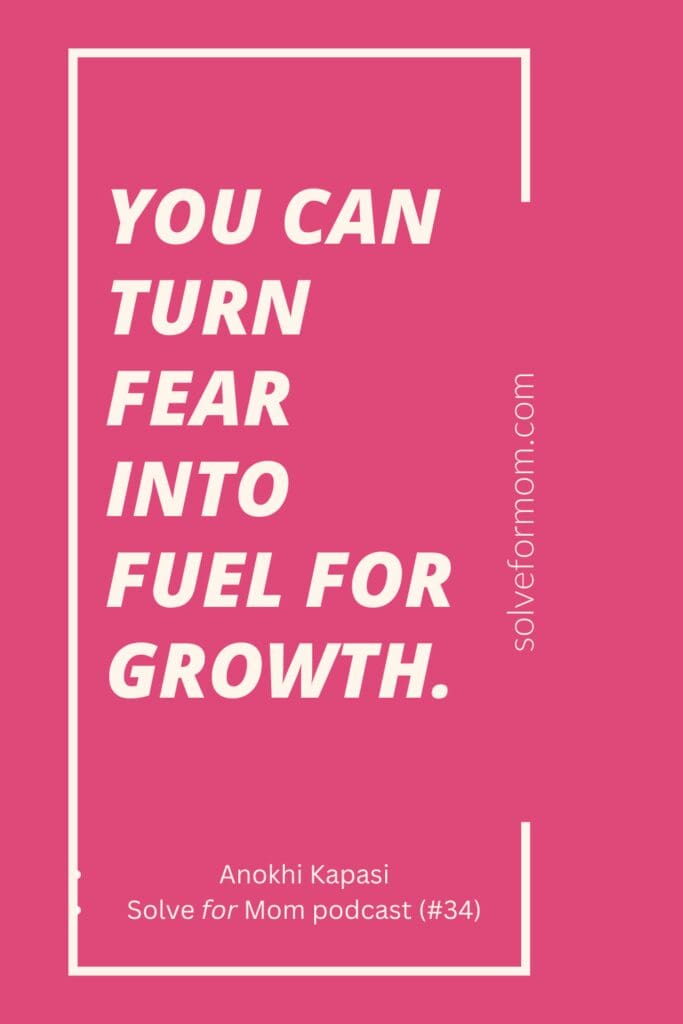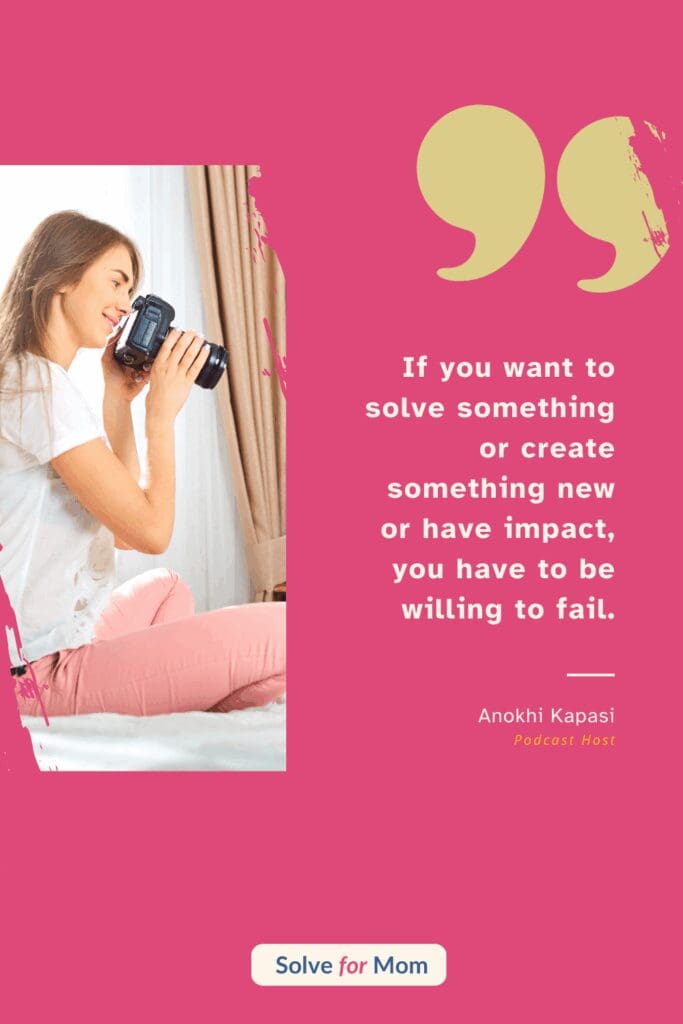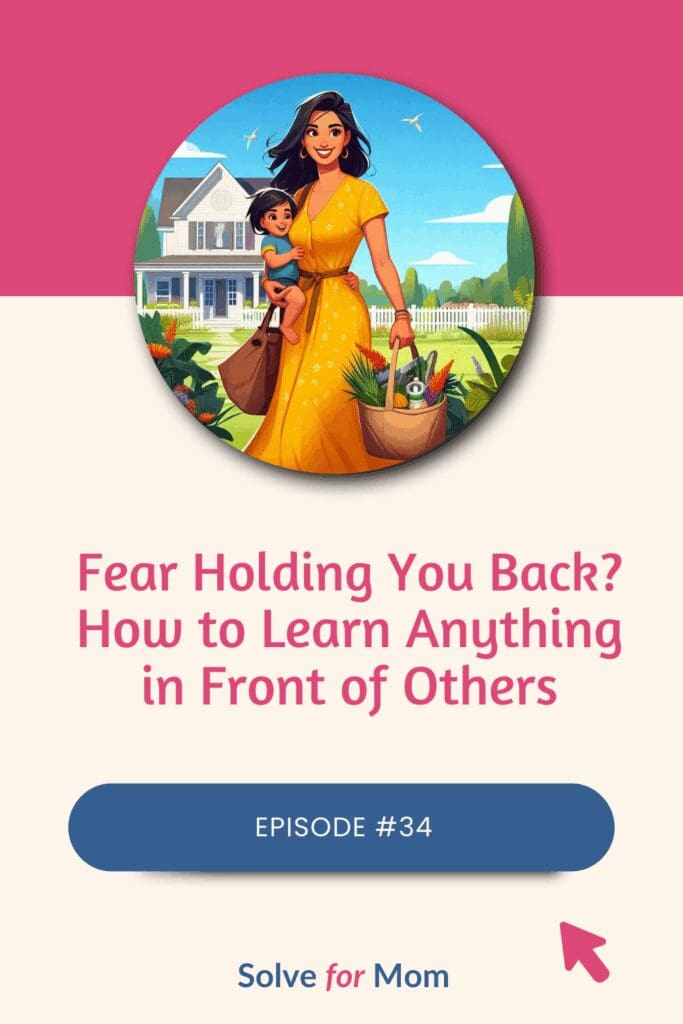- freebies -
It's All Yours
- blog posts -
Must-Read
If it involves goals, planning, and helping you live out your supermom dreams without compromising your time, energy, or family connection, then I'm betting we have a lot to talk about.
Stay Committed to How You Plan To Show Up for Yourself
How to Continue Learning as a Mom in Front of Others
July 22, 2025
Have you ever wanted to continue learning something or build a new skill but felt paralyzed by the fear of making mistakes in front of others? Perhaps you’ve dreamed of taking up painting, learning a new language, or starting a side business—but the fear of judgment has held you back.
It is a struggle learning new things as a mom—juggling family life and trying to continue learning in a chaotic environment, especially with people around constantly. It feels overwhelming, right?
As moms, we often learn and teach simultaneously. This creates unique challenges.
As both a scientist and a mom, I’ve learned countless new skills with others watching—from presenting research to fellow scientists to figuring out homeschooling for my kids (and that’s something you definitely can’t hide from!).
That’s why today I’m sharing mindset shifts and practical strategies to help you overcome the fear of learning in front of others.
You’ll discover how to transform that nervous energy into fuel for growth and make progress on your goals, even when you feel like all eyes are on you. So, if you’re ready to break free from that fear that’s holding you back, let’s dive in.

Why a Mom’s Daily Environment Makes it Tough to Continue Learning
Have you ever thought about how motherhood basically is this endless stream of personal growth? Every day is an opportunity to learn new things and try new things.
But the reality of our mom lives is that learning is done completely differently than when we were students in school, right?
Our environments for learning are just so different because they’re chaotic, sometimes even loud. It’s so hard to get alone time and everything we do, including learning, happens in these small chunks of time instead of having large blocks of availability.
And even those golden times that we often depend on, like when your baby is napping, can actually be more unpredictable than we hope. Like if a baby wakes up mid-nap, especially during regressions or transitions. And as one of my clients puts it, “there are little people around all of the time.”
That is hardly the optimal environment for learning.
But if we don’t take advantage of these windows of opportunity as and when they present themselves, then we’d never continue learning or growing.
Of course, there are ways to help you achieve better learning conditions through planning and systems and organization.
But at some point, you’re going to likely find that you’re still having to learn in this crazy environment. This has happened to me so many times when I’ve tried to learn something as a mom.

It Can be Scary to Continue Learning In Front of Others
Cooking is a real challenge for me—I’m constantly learning new recipes. When we host dinner parties, my cooking gets put to the ultimate test as family and friends gather to eat what I’ve prepared.
As a mom, I sometimes need to tackle crafty projects despite not being naturally artistic. Once, when my son was obsessed with Star Wars, I took on the challenge of creating a Death Star piñata. I learned everything from YouTube tutorials, gathered my supplies, and dove right in. Though it wasn’t perfect, it became the party’s centerpiece. My only regret? Not taking a photo of my creation.
Here’s another challenging example: In 2020, after taking an eighteen-month break from work, I needed to restart my career through job interviews. The process was especially daunting because I hadn’t interviewed in a decade—and I had to do it in front of people from my professional network, former colleagues who I’d crossed paths with before. It was incredibly nerve-wracking.
Perhaps my best example is this podcast. I learned podcasting from scratch and launched this show while building a business—all in front of both familiar faces and complete strangers.
It’s perfectly natural to worry about making mistakes while others are watching, or to hesitate starting something new for fear of judgment.

Fear of Taking Action on Personal Growth
You’re not alone in feeling this way. According to statistics, about 30% of the adult U.S. population—experiences anxiety at some point. This shows just how common these feelings are.
Being a mom doesn’t make us immune to fears. I want to focus on a specific one: the fear of learning in front of others.
In all the examples I shared earlier, I felt vulnerable because I was trying something new. That nervous energy initially held me back from starting. Take my podcast journey—the idea went through several iterations, evolving from one concept to another.
What we really want is to continue learning and make progress on our personal goals, even when we lack private space or time, and even when others are watching and potentially judging us. We want to feel confident trying new things with an audience present and learn new skills efficiently—even in a chaotic environment.
What will other people think?
For two years, I sat on this idea because I worried about others’ opinions. I hesitated to venture outside my expertise, knowing people could leave reviews—just as I’m asking you to do now.
When I first contemplated starting this podcast, I worried about people judging both my choice and my abilities, given my lack of experience. For those two years, it remained just an idea in my head, though I knew eventually I needed to commit.
Finally, I took action. I began by simply discussing the topic, then gradually started mentioning it as a potential podcast. Once I overcame that mindset block, I could move forward with my big ideas. It was like a snowball gaining momentum.
I started imperfectly and messily—and yes, with some drama.
Even now, I’m still learning and far from perfect. In fact, I recorded all my early episodes, including the intro and outro, with my microphone backwards! The audio quality didn’t improve until after episode three.

How to Continue Learning With Confidence as a Mom
The key is that I took action and learned along the way. Now I’ll share how I transformed my nervous energy and fear into something productive and motivating.
1. Continue learning by being a role model
Let’s start with something you hear me say often: We are role models for our kids.
We have to model a growth mindset for our children. If we let fears hold us back from pursuing our goals—whether that’s big ideas, a new job, or other aspirations—what message does that send when fear becomes an excuse to stop moving forward?
That’s not the lesson we want to teach them.
Our choices and responses to challenges and fear will have lasting impacts on our children’s lives.
We must be intentional about pushing through these mental barriers, as our actions will influence future generations. We need to show our children how to embrace challenges and opportunities for growth, exploration, and improvement. Unless there’s a genuine logistical barrier, fear alone shouldn’t stop us.
When it comes to learning in front of others, we must demonstrate how to overcome that fear.
The key is honesty—tell your children what you’re doing, how you’re feeling, what outcomes you expect, and why you’re persisting.
For example, with my kids, I’ll say, “I’m trying a new recipe. Do you have any tips? I’m a bit nervous because 50 people will be eating this meal, and I’ve never made it before.” I’ll ask, “Do you want to help me?”
These conversations aren’t excuses—they’re authentic acknowledgments of the situation, and your feelings and fears are valid.
When we share our feelings with our children and then take action despite those fears, they learn firsthand how to overcome challenges. Yes, things might not go perfectly, and we might fail—but we’ll proceed anyway, knowing those are possible outcomes. Sharing your intentions, especially with your children, creates natural accountability.
And remember: more often than not, your kids will be your biggest cheerleaders.
2. Why hands-on experience helps you continue learning effectively
Active learning through hands-on practice is essential. While we can learn passively through reading, watching videos, or listening, truly understanding something comes from direct experience. When you actively engage with what you’re learning, it becomes concrete and tangible because you’re using all your senses.
This multi-sensory engagement activates more neural pathways in your brain. As the saying goes, “neurons that fire together, wire together“—making experiential learning particularly powerful.
Taking action is the only way to transform your big ideas into reality.
We often discuss vision during life planning, but to achieve that vision, you must continue learning and doing. As moms, this means we’ll need to practice and learn in front of our families, friends, and the wider world.
3. How to continue learning despite fear and anxiety
The next step is to address fear head-on. You don’t need to make the fear disappear completely.
Running away from fears only gives anxiety more power.
Instead, I let the fear have its moment by focusing on the biology behind it. As a scientist, this is my comfort zone. I observe what’s happening in my body when fear arises, creating self-awareness of my discomfort.
I recognize that my amygdala—the primitive “lizard brain” in the limbic system—is activating.
When the amygdala is stimulated, it triggers physical symptoms: sweating, increased heart rate, and sometimes light-headedness. These physical symptoms actually come before we consciously realize we’re afraid. I’ve learned to pay attention to these physical signs.
I remind myself that these feelings are normal—they’re part of my biological design and serve a purpose. In nature, anxiety functions as self-preservation.
When you encounter genuine danger, fear signals your body to protect itself. However, in our modern world, we often experience anxiety about things that aren’t truly threatening. There are real fears and what I call “phantom fears.”
Real fears are useful
They protect and guide us. Phantom fears, however, can needlessly paralyze us.
I deconstruct the situation by working backward. When I notice I’m afraid, I ask myself: What am I feeling physically? What’s different in my body?
I acknowledge why these symptoms are occurring and check whether this is a valid fear or a phantom fear. This process helps me address the fear and give it its moment without letting it disrupt my life.
Don’t let fear paralyze you or accept society’s message that something is scary.
While most successful entrepreneurs have faced fear, the successful ones didn’t let it stop them. If you want to create impact and add value to the world, you’ll need to overcome these fears of learning in front of others.

4. Continue learning through failure
Overcoming this fear helps conquer perfectionism—which is essentially the fear of being judged. That’s why we feel everything needs to be perfect before moving forward. Let me explain how to push through this fear.
I mentioned noticing physical symptoms, but I also assess other factors.
- I examine what triggered the fear.
- I analyze my thoughts about it.
- I observe my emotional & behavioral knee-jerk reactions.
Through these quick body and mental scans, you’ll start recognizing patterns—what situations consistently trigger your fear. You might notice fear arising whenever you need to learn in chaotic environments or in front of others. Once you identify these patterns, you can often manage these triggers proactively and push forward with your goals.
People typically show us more grace than we give ourselves.
My kids always see the best in me, even when I’m critical of my performance. My kids regularly tell me, “Mama, that was awesome! You did such a good job!” They lead with such positive encouragement.
The same applies to my friends and family. They care more about my experience than the outcome—whether I enjoyed it or found it valuable. They rarely judge my performance or results.
Learning—especially in front of others—inevitably involves failure. It’s simply part of the journey.
But don’t confuse mistakes with failure.
Every mistake offers a lesson. There’s always something to learn.
When you combine a mistake with a lesson, you’ve actually succeeded and can continue learning from that point forward.
If you want to solve something or create something new or have impact, you have to be willing to fail. Even when it feels like you’re moving backward, you’re making progress—it’s just not always visible.
Failing is proof that you’ve tried—that you’ve taken that crucial first step.
That’s what matters most. So what if your first attempt didn’t work? Learn from it. Treat it as an experiment.
Try again with slight modifications. Find one thing you can improve by 1% to get closer to your goal. Remember, needing to make changes doesn’t mean you’ve failed.
If the outcome isn’t what you wanted, you have plenty of opportunities to refine it. That’s learning by definition.
When you make changes, don’t act from shame. Don’t feel bad about trying again differently. Instead, approach it with devotion, curiosity, and a desire to improve.
Each refinement adds up. It’s rare to have an idea, take action, and achieve perfection immediately. I know the perfectionist in us wants to wait until we’re sure everything will be flawless, especially when others are watching.
But the realistic process looks different: you start with your vision, take action—however imperfect or messy—and then focus on the crucial step of refining and incorporating feedback. Sometimes this last step requires multiple iterations. That’s where most of our time goes.
Facing your fears is part of the process
If you let fear hold you back, you’ll never move beyond the idea phase.
This learning-through-failure approach defined my PhD experience. In my laboratory-based molecular pathology program, we constantly tested ideas through experimentation. My PhD took six years.
The first four and a half years were mostly failed experiments. Though I had occasional successes, it felt like an endless series of ideas that didn’t work and assays that needed correction. With each failure, I’d troubleshoot, changing one parameter at a time.
Each attempt taught me something new, bringing me closer to success. Around year four and a half, things finally clicked. Once something started working, other pieces fell into place more easily.
Of those six years, I spent perhaps one and a half years conducting the successful experiments that formed my dissertation’s story. From the outside, it might have looked like four and a half years of failure.
But here’s what matters: I succeeded in the end. I earned my degree—the same degree as everyone else in my program.
5. Trust your ability to continue learning in any situation
The final key is trusting in your ability to figure things out. As a high-achieving, independent woman, you’ve had many successes—each one started as something new that you mastered. This doesn’t change when you become a mom.
These successes remain part of your story. Your ability to continue learning, whether it’s something new now or doing it in front of others, stays the same. Success builds confidence.
Early in my career, I took an internship that was completely different from my graduate degree in molecular pathology. The role focused on statistics and pharmaceuticals—with entirely different research methods and analyses.
I chose this internship because it was crucial for my career goals. The program was designed to be temporary, and the company never hired their interns permanently. However, I performed so well that they made an exception and hired me.
Growth mindset is crucial to being a lifelong learner
What made the difference? I started with the right mindset. I believed that with persistence, I could figure anything out. This same principle applies to learning as a mom—even with others around you.
You can approach any challenge with confidence, knowing you’ll eventually figure it out.
When learning something new, there are different levels of risk you can take. Each attempt carries a different cost if things go wrong. The key is to assess these costs and choose an appropriate starting point.
Start gradually. As an intern, I didn’t tackle the biggest projects right away. Instead, I began with simple tasks like writing emails. This helped me learn the field’s terminology naturally, as I had to use the correct language in client communications. As your experience grows and the risk of mistakes decreases, you can take on bigger challenges.
As a novice intern, I wasn’t about to risk a project worth hundreds of thousands of dollars. By the end of my internship, though, I was handling major projects with significant responsibilities—but I had worked my way up to that level.
When approaching any learning challenge, start by assessing what you know and what you need to learn. Identify the gaps, then determine how to acquire that missing knowledge. Break down the work into manageable pieces, and tackle one thing at a time.

Practical Ways to Continue Learning Despite a Busy Mom Schedule
Learning is a journey, especially when we navigate it in front of others. We’ve explored how to embrace the learning process even when feeling vulnerable.
We covered several practical strategies to help you grow and learn confidently when others are watching. Let me recap these takeaways.
- Being a role model for our children means embracing new challenges openly
- Hands-on experience is crucial for effective learning
- Manage fears sing cognitive behavioral therapy (CBT) techniques
- Failing is a vital part of the learning process
- Trust in your ability to figure things out
Remember, it’s completely normal to feel hesitant about learning in front of others.
With the mindset shifts and practical solutions we discussed today, you can transform that fear into fuel for growth. You can take action on that new thing you want to try or master that skill you want to learn.
PICK ONE TIP TO TRY TODAY
- 🔲 Sign up for my newsletter. I bring this same raw honesty about my business – and taking action to build & grow it in front of others.
- 🔲 Create a progress tracking system to monitor learning improvements
- 🔲 Break down new skills into smaller, manageable chunks
- 🔲 Practice addressing fears by scanning changes in your body
- 🔲 Find a low-risk activity to try first (before you gradually increase complexity)
IF YOU LIKED THIS BLOG
- Subscribe to the podcast and share it with other high-achieving mothers
- Ask me and your question could be the topic of an upcoming Solve for Mom podcast episode!
5 Ways Moms Can Learn a New Skill in 15 Minutes
EP 24: Want to Be the Best Version of You? Must-Have Personal Growth Playbook for Moms!
EP 32: Pursue Your Dreams! How Moms Make Big Ideas Happen [Spring Into Action Series]
Leave a Reply